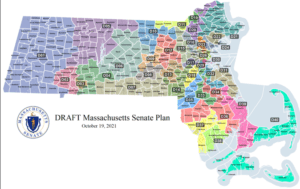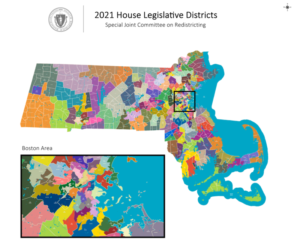Who is a member?
Our members are the local governments of Massachusetts and their elected and appointed leadership.

The proposed Senate district map would double the number of majority-minority districts from three to six, out of a total of 40 Senate districts.
On Oct. 3, Gov. Charlie Baker signed legislation to make a one-time change in the decennial redistricting process by letting state lawmakers draw legislative districts first and then giving municipalities 30 days to finalize their own voting precinct lines.
Facing a truncated timeline to pass redistricting legislation affecting federal and state legislative districts, lawmakers sought to reverse the conventional order and have the state enact redistricting legislation prior to new municipal precinct maps being finalized.
This week, the Legislature finished its work on new House and Senate district boundaries, set to be in effect for the 2022 state election cycle.

In the proposed House district map, 33 of the 160 House districts would be majority-minority districts, an increase from the current 20.
The House and Senate maps both propose an increase in the number of majority-minority districts, where non-white residents make up a majority of the district’s population. Out of 160 House districts, 33 will be majority-minority districts, an increase from the current 20. For the 40 Senate districts, the figure will double to six (from three).
Gov. Baker has 10 days to review the new district legislation. It’s unclear if he has any concerns with the proposals from the House and Senate.
Legislative leaders are also expected to release draft maps of new congressional and Governor’s Council districts in the coming weeks.
Though the so-called reprecincting law delays the official municipal reprecincting process until after the Legislature concludes its mapping of state and federal districts, it does not require precincts to follow legislative district lines. Once the Legislature has completed the state and federal districts, cities and towns will have 30 days to complete their reprecincting process, as long as they finish by Dec. 15.
Normally, cities and towns use data from the U.S. Census Bureau every 10 years to update their precinct lines, which are then used by state leaders to redraw federal and state legislative districts. Because of the federal government’s pandemic-related delay in generating official Census numbers, cities and towns have been unable to finalize their reprecincting process.
Throughout the legislative process, the MMA made the case that legislation to shift the reprecincting process to after redistricting could add significant confusion and complexity to the electoral process in areas where legislative districts bisect precincts. This is particularly important in cities and towns that use precincts to elect city and town councillors, school committees, town meeting members, or other officials. Members are strongly encouraged to work closely with their state legislative delegation to reconcile any potential issues to their local reprecincting process.